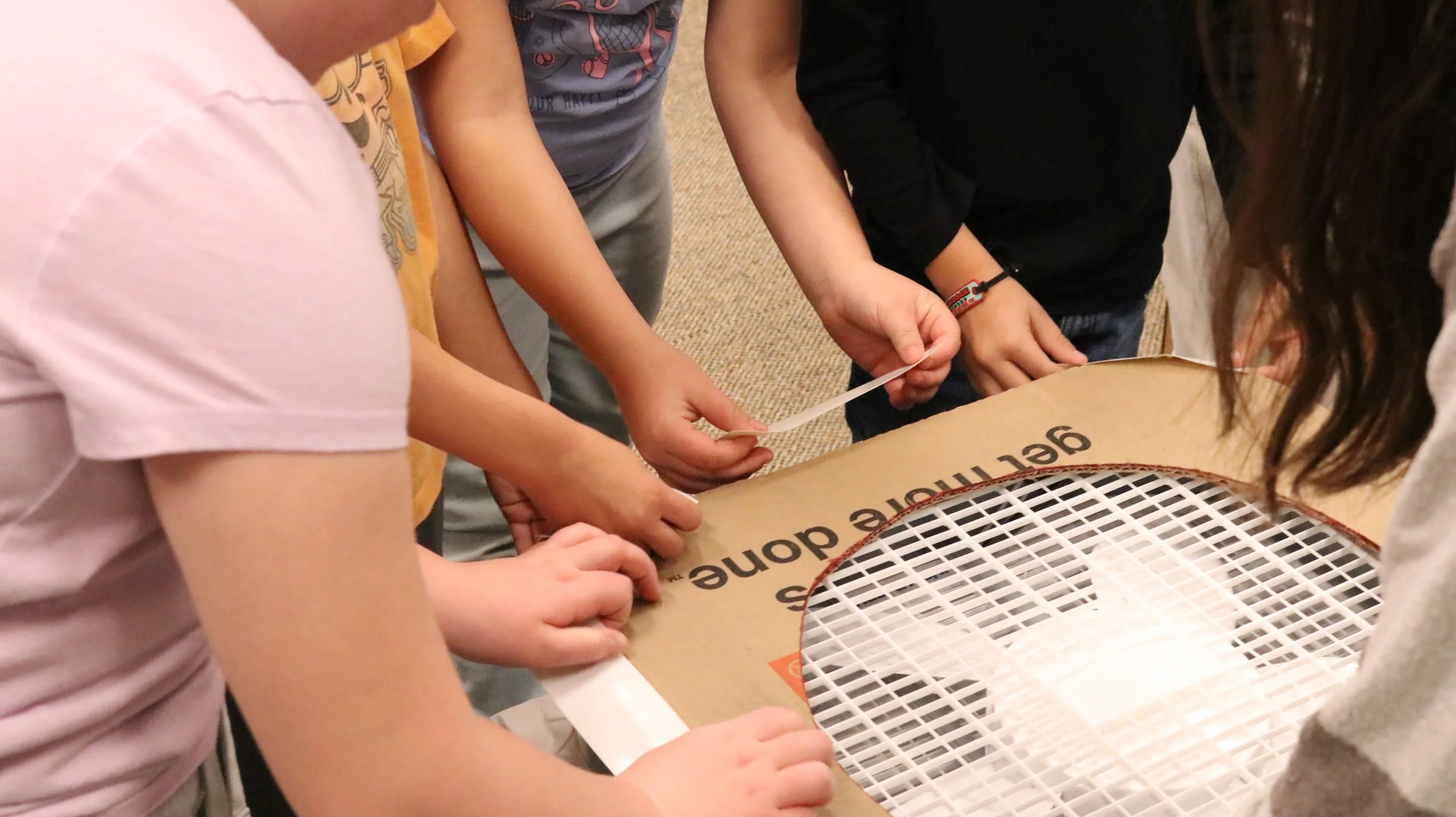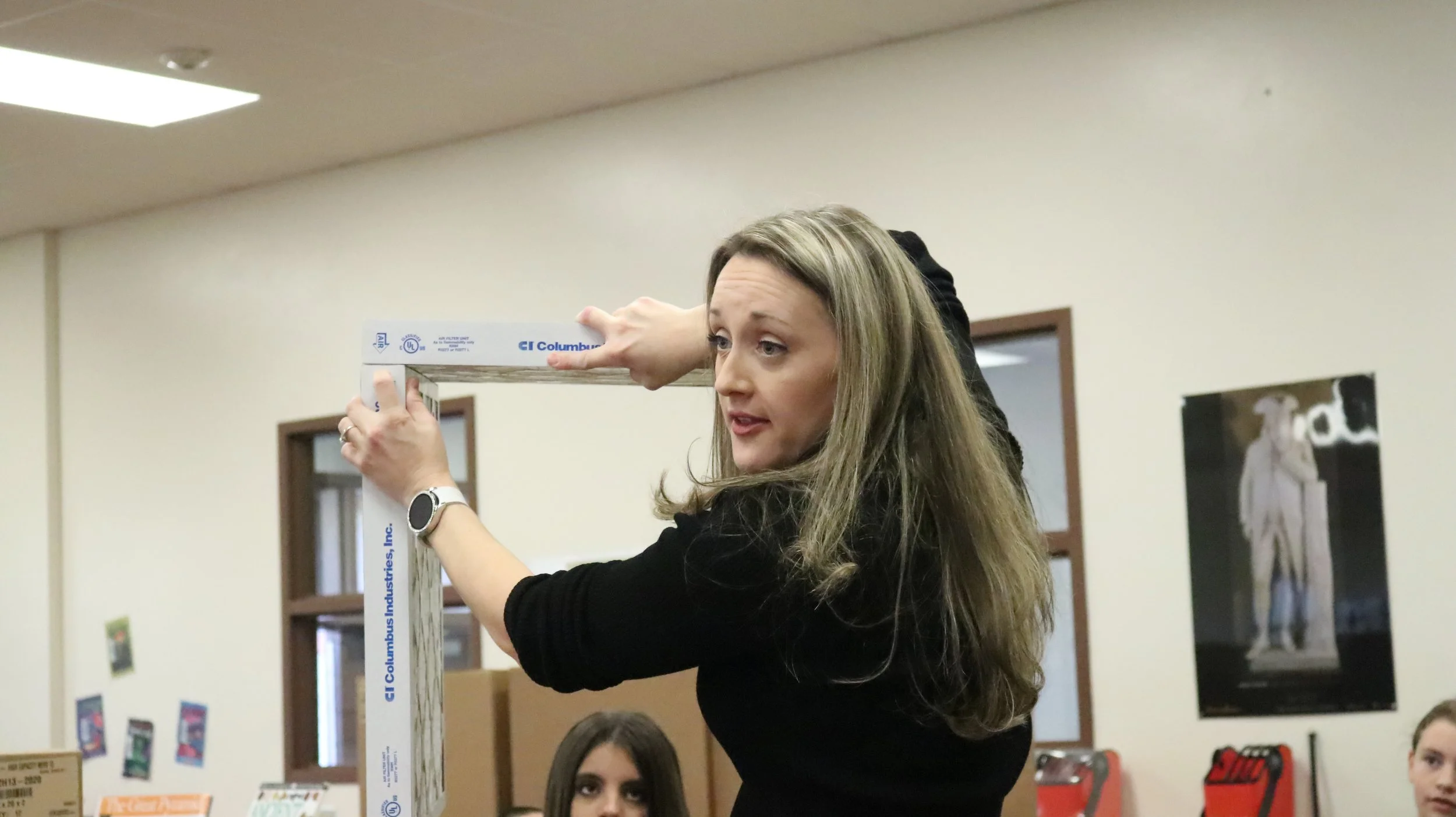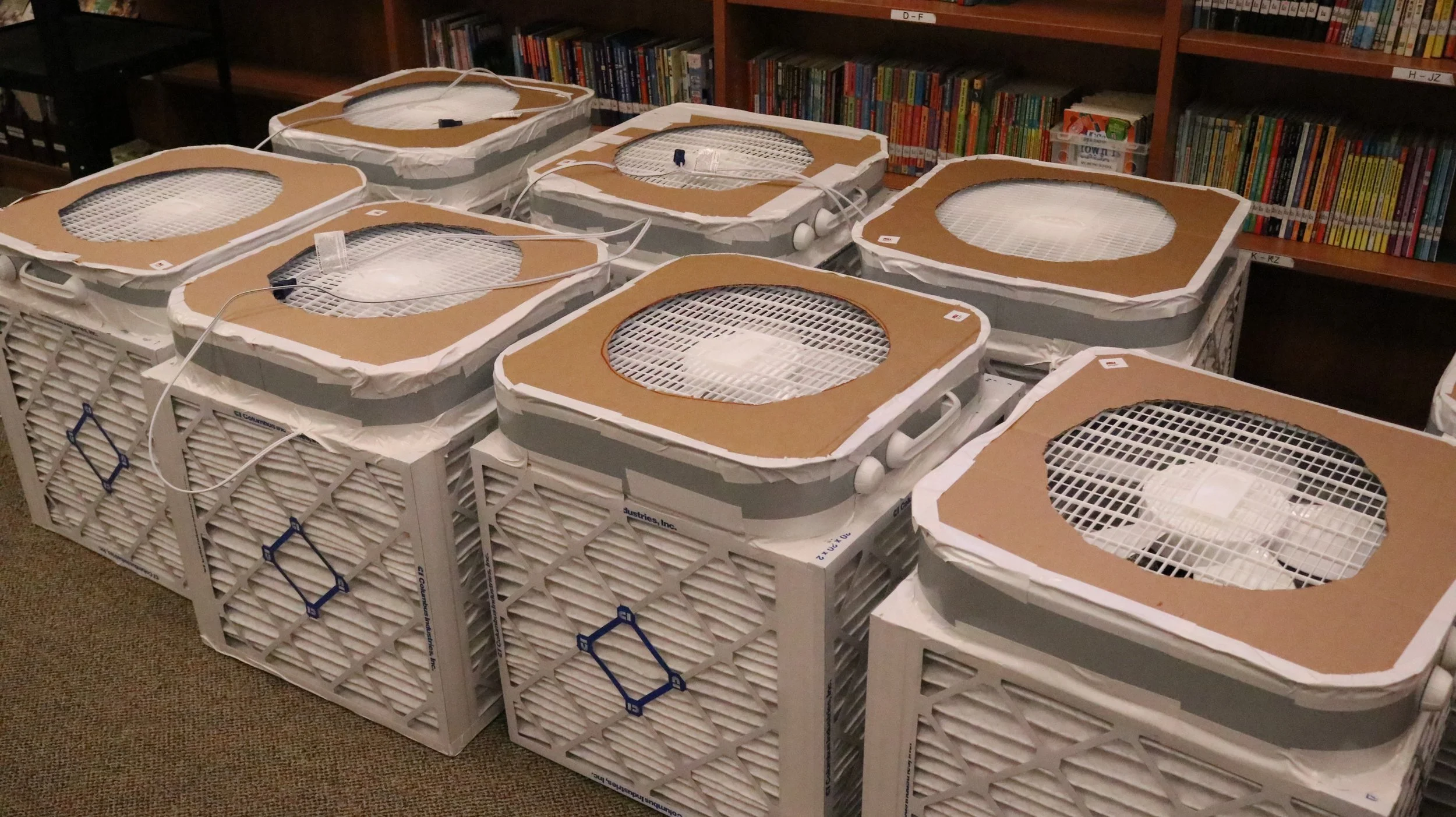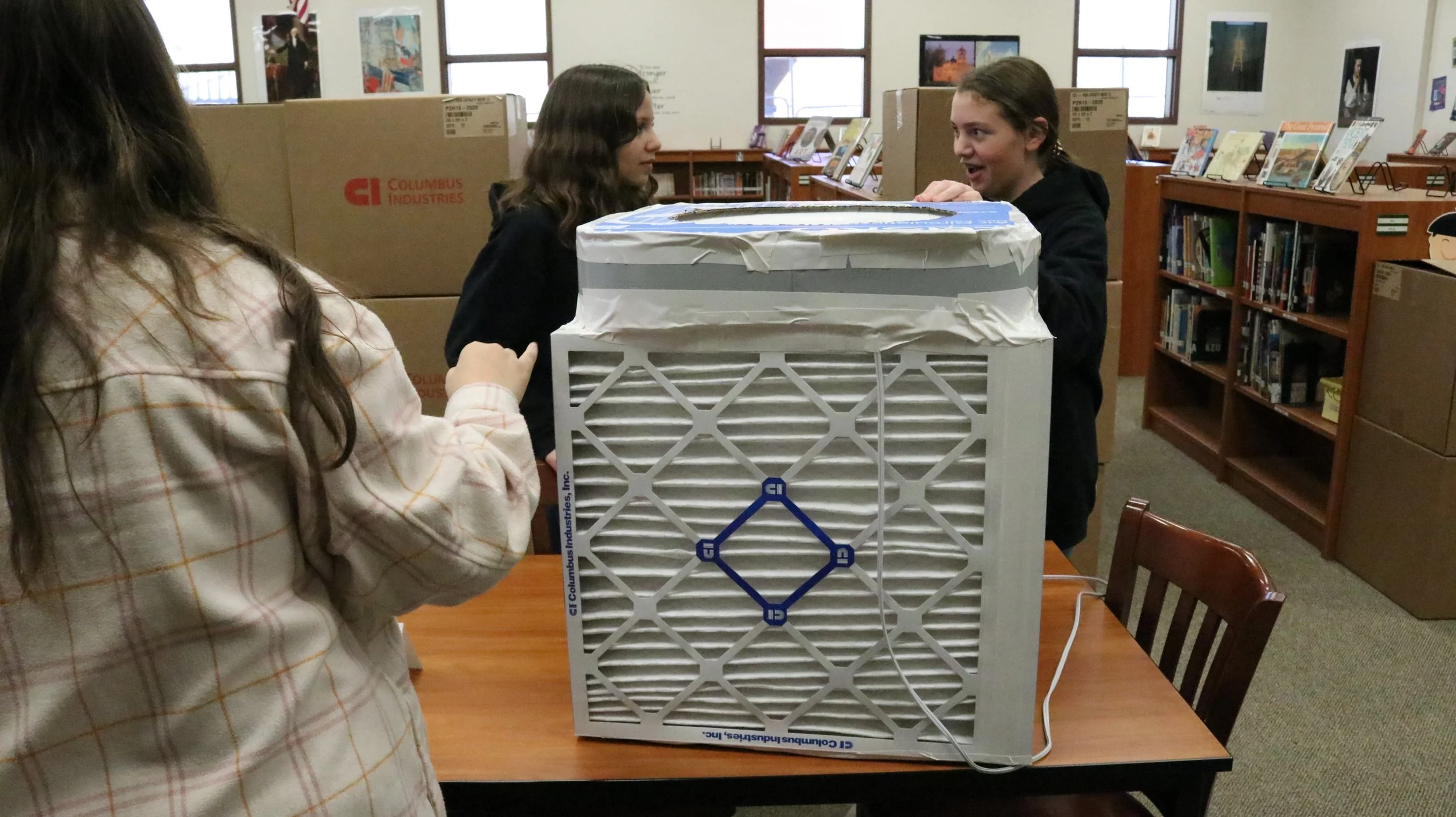In Southern AZ, an entire K-8 school tackles dust, COVID-19 with DIY air purifiers
Students at Red Rock Elementary School in Arizona built dozens of box-fan air filters known as Corsi-Rosenthal Boxes in a schoolwide event on Feb. 2, 2023. An air quality team from Arizona State University supported students and teachers in the effort, which marked the first time an entire school was outfitted with the devices through the team’s work. (Photo: Diana Alba Soular/ SNMJC)
RED ROCK, ARIZONA – Dozens of students huddle around sheets of cardboard in the school library, as a teacher occasionally shouts out directions. Happy chatter fills the room, as kids use child-friendly cutters to shape the cardboard into its new purpose: as a component of DIY, box-fan air purifiers that have been described as an “under-utilized” tool in combating the COVID-19 pandemic.
For Red Rock Elementary, air quality has long been a concern. Located in a dusty desert about 30 miles north of Tucson, the single-school district is close to a cattle feedlot, a train track, and a heavily traveled segment of Interstate 10. In addition to dust, COVID-19 and other airborne viruses like RSV have pushed concerns about indoor air quality to the forefront like never before.
As recently as December, Red Red Rock Elementary, like many schools, was hit by the so-called “tripledemic,” spiking student absences.
“Right before winter break, we had one-fourth of our kids absent,” said teacher Tiffany Massie. “For about a week, we had so many kids absent with COVID, the flu and RSV all going around.”
Classrooms – and not just at Red Rock Elementary – are the perfect environment to spread COVID-19 and other respiratory viruses. Students, often in groups of 20 or so, sit close to one another in the same room for extended periods of time. Without top-notch air circulation and filtering going on, they’re likely to breathe in air that someone else has exhaled.
Spread of the COVID-19 virus has created a relatively new public health concern for students and teachers, but even before the pandemic, air quality wasn’t great for classrooms across the country, said Dr. Megan Jehn, an Arizona State University associate professor of epidemiology. At issue is that for the freshest and safest air, a room’s ventilation system should turn over its air at least six times per hour. But schools often have outdated or aging systems that are achieving only a single turnover of a classroom’s air.
“We have decades of research linking poor indoor air quality to health. This is not a new area,” she said. “We’ve known for a long time it can cause asthma, it can lead to school absences, transmission of respiratory diseases, and a loss of focus.”
Tiffany Massie, Red Rock Elementary teacher for the Gifted and Talented Education Program, explains to students on Feb. 2 how to assemble air filters as part of a do-it-yourself air cleaner that will help purify air in classrooms throughout the school. (Photo: Diana Alba Soular/ SNMJC)
Cleaner air for an entire school
Rather than ignoring a tough challenge – how to get cleaner air for an entire 475-student elementary and middle school – Red Rock Elementary decided to take matters into its own hands, launching a multi-pronged, multi-month effort that culminated Feb. 2 with a schoolwide, air-purifier construction event. Classroom by classroom, students filed into the school library throughout the day to assemble more than 50 Corsi-Rosenthal Boxes – build-it-yourself air cleaning devices that cost $100 apiece or less, a fraction of the cost of commercially available air purifiers for rooms. The event showed what’s possible when a district, backed by supportive experts, prioritizes safer air for its students, staff and teachers.
Some attempts in the Las Cruces Public Schools are being made to combat similar air quality challenges, particularly the spread of coronavirus. Thanks to student and parent leadership and teacher support, Mesilla Valley Leadership Academy has outfitted its middle school with Corsi-Rosenthal Boxes. At least two classrooms at Arrowhead Park Early College High School also have made use of the devices.
An Arizona State University team focused on air quality has helped classrooms across Arizona to deploy Corsi-Rosenthal Boxes, but Red Rock Elementary’s event was the first time it helped outfit an entire school with the devices. The connections between indoor air quality and student well-being and performance were motivating factors in building boxes for the whole school, officials said.
“We decided, in a rural school, you don’t depend on anyone else,” said Red Rock Elementary Superintendent Peter Dwyer. “You just do what you need to do. We kind of made our own path on this.”
A study in the Netherlands found that students who were exposed to higher levels of carbon dioxide – the gas humans exhale – in their classrooms performed worse on standardized tests than their counterparts. (Corsi-Rosenthal Boxes don’t remove carbon dioxide from the air. However, high levels of the gas indoors are an indication of poor ventilation in a room and mean that people are almost certainly breathing in air that’s been exhaled by someone else, according to Jehn.)
In Red Rock Elementary’s quest for cleaner air, several factors appeared to contribute to its success so far. First, the district’s administration and key staffers were on board with tackling the problem of poor indoor air quality in classrooms. While the challenge plagues schools across the U.S., it is for the most part an invisible threat and, therefore, easy to ignore. Second, the school engaged a core group of students early on in its initiative, turning the Corsi-Rosenthal Box project into a multi-faceted opportunity for learning. Those students in turn engaged other students, as well as community residents, who donated funds towards the boxes. The district turned the box-building event into a full-fledged activity – complete with a party for the best-decorated Corsi-Rosenthal Box -- that generated a lot of enthusiasm among students. And lastly, the district had access to air quality experts from a major in-state university, which offered technical support and helped take the event to another level.
The district partnered with ASU to turn the initiative into a science-based learning project for kids, as well as an actual scientific study that will help gauge the effectiveness of Corsi-Rosenthal Boxes, which continue to gain traction worldwide as a way to combat airborne viruses indoors. Among the particles captured by the boxes are the potentially virus-laden aerosol droplets people release into the air while breathing and talking.
Completed Corsi-Rosenthal Boxes, a type of air purifier that can be built for homes, workplaces and classrooms, are seen at a Feb. 2, 2023 schoolwide build event in Red Rock, Arizona. (Photo: Diana Alba Soular/ SNMJC)
What’s a Corsi-Rosenthal Box?
Corsi-Rosenthal Boxes were developed by two inventors during the pandemic as a quick, relatively affordable strategy to help people reduce air pollution and virus particles in their classrooms, workplaces and homes.
A Corsi-Rosenthal Box comprises at least four, high-grade MERV 13 air filters (some versions of the box use five) of the type you might find in your home’s furnace. Fused together with duct tape, the filters form the walls of the box. A piece of cardboard forms the bottom. And a box fan – the $25 version found at most big-box retailers – sits on top, sucking air through the filters and up through the box.
“There is a lot of invisible particulate matter that’s floating around in the air around us,” Jehn, the ASU researcher, said. “Some of these are respiratory droplets that can carry viruses. Others are allergens. When you turn on the fan, it draws air through the filters, and they have an electric static charge to them. Particulate matter gets stuck in the filter medium.”
Notably, those particles get stuck in the filters – not a person’s airways.
As part of the box-building event in Arizona, an ASU team led by Jehn set up air quality monitoring equipment in 10 classrooms at Red Rock Elementary. It includes an instrument that measures the prevalence of particles of different sizes in the classrooms’ air. They also installed humidifiers, which produce water droplets akin to those humans exhale, that will be used to run experiments at nighttime while students aren’t in the classrooms. The equipment, including the room’s Corsi-Rosenthal Box, will be connected to smart plugs, so researchers can control them remotely. The study will run through the spring semester.
Tanya Palit, project manager for ASU’s Applied Infectious Disease Epidemiology Lab, said the equipment will help to gauge how many times the air is being cleaned or refreshed per hour. The higher the refresh rate, the better. Also, it will gauge by how much particles in the air decrease when the Corsi-Rosenthal Boxes are turned on. Researchers also will be looking into some of the social aspects of the boxes – like do students or teachers turn them off because they’re too noisy?
While it will take months to collect full data, researchers are able to monitor the air quality real-time using a laptop. They notice that, even within an hour of turning on the Corsi-Rosenthal fans, the amount of particles floating around in a room’s air plummets.
Research is still being carried out on the effectiveness of Corsi-Rosenthal Boxes, but a growing body of evidence is showing strong positive results. The devices, Jehn said, are shown to reduce small air particles that can contain viruses by up to 70%, meaning there’s less exposure to viruses in those particles. But what’s lacking is data connecting that higher-quality air created by the boxes to better health outcomes in classrooms.
The research at Red Rock Elementary will help lay the groundwork for connecting those dots.
In a different study, Corsi-Rosenthal Boxes were found to cleanse synthetic chemicals found in products like cleaners and textiles, from air, according to research published last year by Brown University and Silent Spring Institute. Chemicals were reduced by 30 to 60 percent.
A closer look
Red Rock Elementary School delved into the Corsi-Rosenthal Box project in October of last year after receiving an informational email from their county’s health department. Dwyer assigned the project to Tiffany Massie, a teacher in the school’s Gifted and Talented Education program. He said her go-getter personality made her the right person for the role.
“Tiffany doesn’t give up,” he said. “When she’s got something, it’s going to be accomplished.”
Corsi-Rosenthal Boxes comprise four or five MERV-13 air filters, of the type found in a home’s HVAC system, a box-fan, and some cardboard. The components are taped together with duct tape. (Photo: Diana Alba Soular/ SNMJC)
Massie incorporated the box-fan air filter project into her own work schedule and into students’ instruction. She reached out to Jehn at ASU, who soon became involved. A core group of students hosted a women in science and STEM panel discussion to learn about air quality. Box namesake Jim Rosenthal, CEO of Texas-Air Filters, attended. Then, students calculated the volume of their classroom spaces, a precursor to measuring air quality. They used gauges to find out the carbon dioxide levels inside classrooms, and found some of them were surprisingly high. They produced videos about air quality in the school. And they spoke to businesses and community leaders as part of fundraising to help pay for Corsi-Rosenthal Box components for their whole school. So far, the group has raised $4,100 for the effort, within reach of its $5,000 goal.
“The kids have ownership of this, and that’s what’s key,” Dwyer said. “Because they understand why those boxes are in their room now.”
In December, two Corsi-Rosenthal Boxes were installed in classrooms as a pilot project, and the air quality in those classrooms improved, school officials said. That led to the expanded effort Feb. 2.
Eighth-grader Wendy Fergus was among the middle-school students spearheading the Corsi-Rosenthal Box project. She said she didn’t think much about classroom air quality in the past but would sometimes notice how rooms would get “stuffy.” Students don’t have much option to leave a room when that happens, she noted.
“This (project) opened my eyes to some more issues that we have,” she said. “And I think it’s really cool to be part of this.”
Leading up to the box-building event, GATE students visited classrooms of younger students, teaching them about the boxes and how to build them. They scaled down some terms – like using “air trap” in place of “Corsi-Rosenthal Box” – to make them more understandable to young children.
The day-long box-building event was a whirlwind of activity that required a lot of planning and coordination to flow as seamlessly as possible. Massie was the point person directing waves of students that visited the library throughout the day. GATE students helped direct the box construction, too.
As for lessons learned, Massie said she’d break up the event into three days to give younger students more time to work on their boxes.
In the days after the box construction event, students decorated their classroom box – part of an effort to build student buy-in for the devices and reduce the chances of students tearing them up, such as by poking pencils in the cardboard. An Eiffel Tower design and Clifford the Big Red Dog were among the creations. The class producing the winning design was awarded a party with food and shaved ices from a favorite local eatery called Eegee’s.
Boxes will need to be replaced
Despite the positives, there are some limitations to Corsi-Rosenthal Boxes as a way to improve classroom air. One of which Red Rock Elementary is well-aware is that the filters eventually must be replaced, and there is a cost to that. The ASU research team will be trying to determine exactly how long the filters can last before needing to be replaced. But the rule of thumb now is every six to nine months.
In addition, replacing the filters will require deconstructing the existing Corsi-Rosenthal Boxes, salvaging the box-fans, and rebuilding the air-cleansing devices. This will require ongoing attention and effort, perhaps at least once a school year, to maintain the fans’ effectiveness in classrooms.
Another possible concern about the Corsi-Rosenthal fans is the noise they make, given they must operate continuously for the best results. Some students and teachers may find them distracting, despite the air quality benefits.
Lastly, the boxes don’t remove all contaminants from the air in a room, but do reduce them significantly.
Still, Jehn said, in the realm of indoor air quality, the devices are a layer of protection for kids and teachers. Every layer, which can include things like upgrading HVAC filters in schools, results in cleaner air – which is better for everyone. Corsi-Rosenthal Boxes can help a classroom achieve an air turnover rate of two or three times more per hour than its rate without the devices. The boxes, she said, are the “one mitigation measure that has really been under-utilized during this pandemic.”
“We have a lot of tools and research out there showing that, if you don’t want to breathe it in, you should filter it out of the air,” she said. “In terms of bang for your buck, that’s the most important thing you could be doing during the pandemic, and we’re just not doing enough of it.”
To see this story at the Las Cruces Sun-News, click here.
To read this story via Yahoo!, click here.





